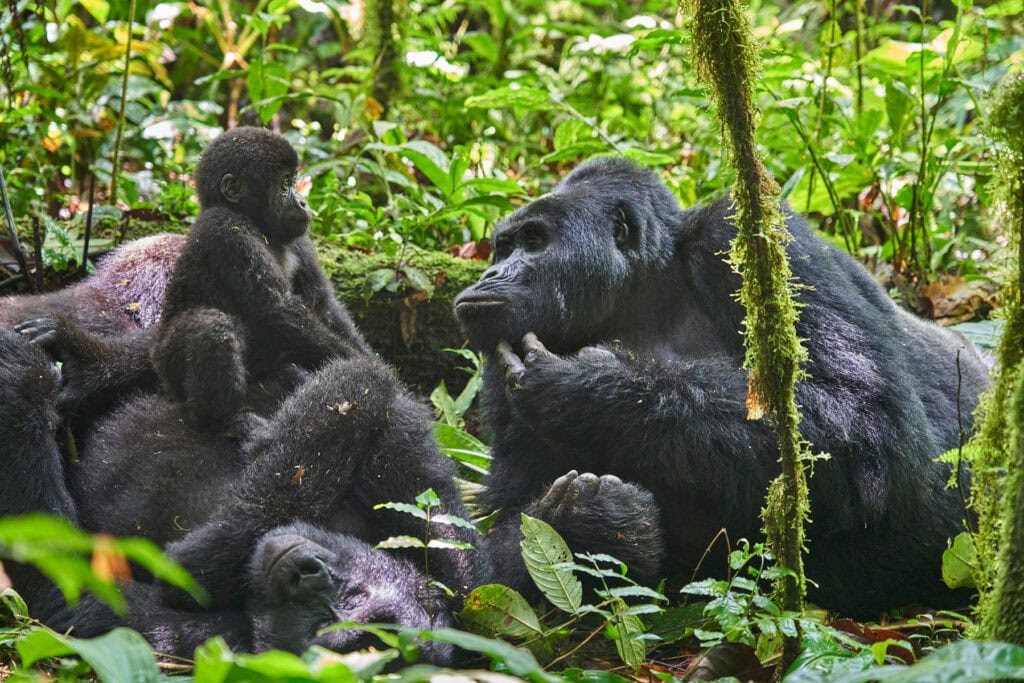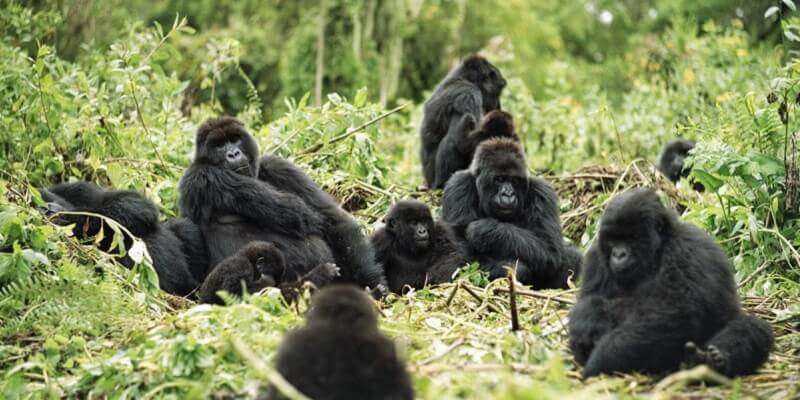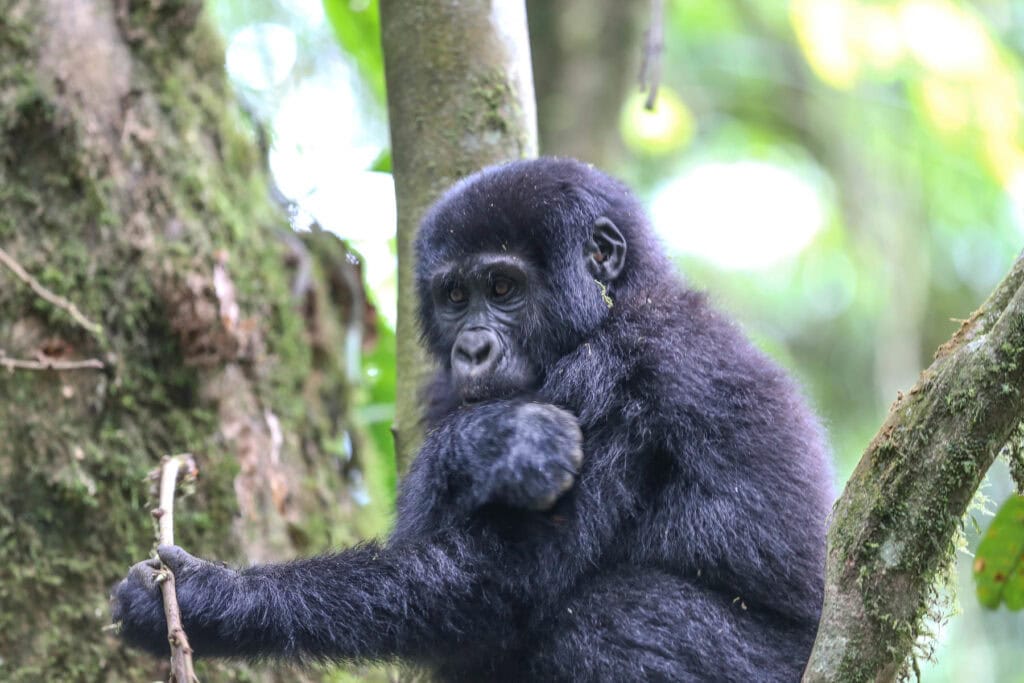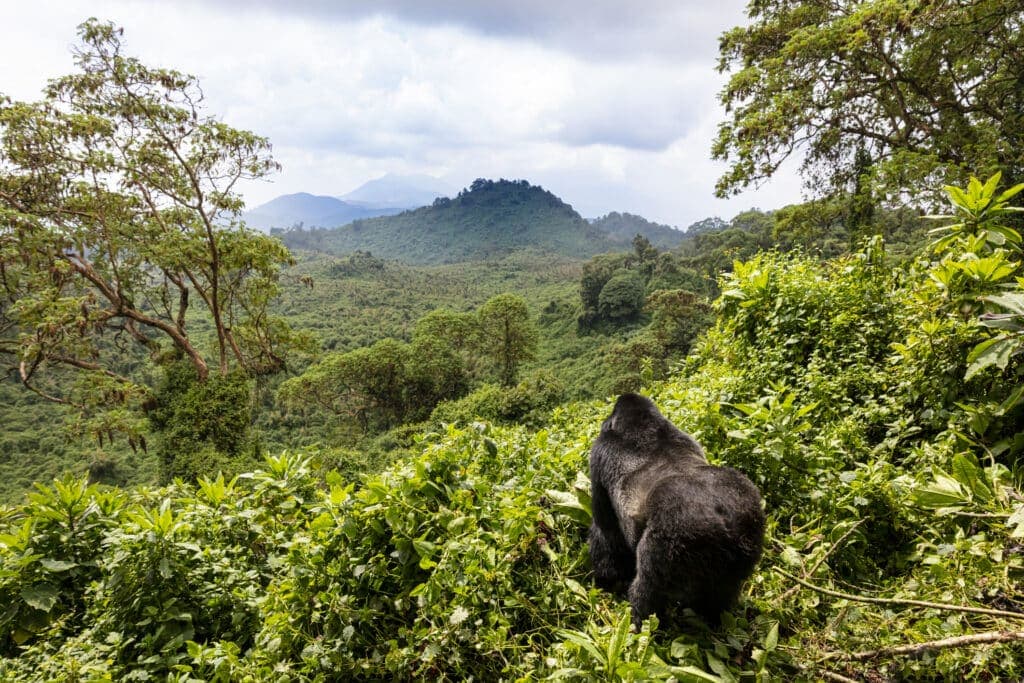Gorilla trekking in the heart of Africa, particularly in Rwanda’s Volcanoes National Park and Uganda’s Bwindi Impenetrable Forest, is an unparalleled experience. These regions offer intimate wildlife encounters with the majestic mountain gorillas in their natural habitat.
However, the success and enjoyment of such a profound journey hinge on thoughtful preparation. This comprehensive guide provides detailed insights into the essential gear and specific tips tailored for gorilla trekking in Rwanda and Uganda.
Essential Gorilla Trek Gear
Specialised Hiking Boots for Mountainous Terrain:
The volcanic terrain in Rwanda and the dense forests in Uganda demand sturdy, waterproof hiking boots with enhanced ankle support. Consider boots with deep treads for optimal grip on muddy slopes and extra padding for comfort during long treks. Breaking in your hiking boots before the trip will help avoid blisters and discomfort.
Protective Clothing for Dense Vegetation:
The foliage in the gorilla’s habitats can be harsh. Pack long-sleeved shirts and durable trousers made of tough, quick-drying material to withstand snagging from thorns. Neutral, earth-toned clothing is recommended, as bright colours may startle the gorillas and dark colours attract tsetse flies.

Adaptable Rain Gear for Equatorial Weather:
Given the region’s equatorial climate, heavy and unpredictable rainfall is common. Carry an ultra-lightweight, breathable rain jacket and waterproof pants. Opt for gear that can be easily put on,, ensuring minimal interruption to your trek.
Heavy-Duty Gardening Gloves:
Navigating through dense brush and nettles means you’ll need protection for your hands. Heavy-duty gardening gloves, preferably with reinforced fingertips, will prevent scratches and irritation from plant contact, enhancing your comfort as you part thick foliage or steady yourself on trees.
DEET-Based Insect Repellent:
Insect repellent is crucial due to the prevalence of insects in humid forests. A DEET-based repellent is highly effective against the notorious tsetse flies found in Uganda’s forests and various mosquitoes carrying malaria.

Sustenance for Energy-Intensive Treks:
Gorilla trekking can last several hours and requires significant energy expenditure. Bring a high-capacity, refillable water bottle and energy-boosting snacks like nuts, dried fruit, and protein bars. Avoid littering to preserve the pristine natural environment.
Comprehensive First Aid Kit:
Your first aid kit should include essentials for trek-specific ailments. Include items for wound care, blister plasters, pain relief, anti-diarrheal medication, and rehydration salts. If you have allergies, ensure you carry necessary medications like antihistamines or inhalers.
Photography Gear with a Focus on Discretion:
Capturing your encounter requires a good camera with a zoom lens, as flash photography is prohibited around the gorillas. Silent or quiet camera settings are crucial to avoid startling the animals. Binoculars are not necessary for gorillas but can be useful for bird watching or spotting distant wildlife.
Adherence to Gorilla Trekking Etiquette
Respect for the gorillas and their habitat is paramount. You’ll need to abide by the distance regulations, keeping 7 meters away from the gorillas to prevent disease transmission. Also, if you’re feeling ill, especially with flu-like symptoms, you should avoid trekking, as gorillas are susceptible to human illnesses.
Ergonomic Backpack for Essentials:
Choose a backpack with ergonomic features, such as padded straps and a hip belt to distribute weight evenly. It should be spacious enough for your rain gear, snacks, water, and first aid kit, with easy-access pockets for items like your camera or repellent.

Altitude Readiness:
The high-altitude environment can challenge even seasoned hikers. If possible, arrive a few days early to acclimate, and consult with your doctor before traveling, especially if you have respiratory or cardiac conditions. Mild altitude sickness is common, so understand the symptoms and remedies.
Local Currency and Essential Documents:
Ensure you have local currency (Rwandan Francs or Ugandan Shillings) for various park fees, tips, and local purchases. Keep your passport, visa information, and vaccination records (especially your yellow fever certificate) readily accessible.
Energy Solutions for Remote Trekking:
With limited access to electricity in remote areas, bring portable solar chargers or extra batteries to keep your devices powered. Remember, you’re trekking to disconnect, so use devices sparingly and immerse yourself in the experience.

Staying Informed and Embracing Flexibility:
Gorilla trekking isn’t a predictable excursion. Daily trekking conditions depend on the gorillas’ movements, so an adaptable attitude is essential. Trust your guides, as they’re experienced in tracking gorillas and understanding their behaviour.
Conservation Contribution:
Understand that a significant portion of your trekking fees contributes to gorilla conservation efforts and community development projects. By participating in this trek, you’re directly contributing to the preservation of these magnificent creatures and their habitat.
Physical and mental preparation for gorilla trekking
It is very important to be mentally and physically ready for this excursion; the fitness of both will make or break this excursion and impact the whole experience greatly. Below are some tips and tricks to help:
Keep active:
Go for walks, jogs, hikes, sit-ups, stair masters and lounges. Always monitor your pace and duration of activity, strive to improve. You can buy a wrist watch that can help keep track of your records. Continue training in all types of weather, carry your loaded backpack and try drinking and eating on the go as well.
Practice patience:
Sit in silence, learn to block out negative thoughts and focus on the goal. Set daily goals leading to the bigger goal as a practice; learn to focus on the present moment so you will appreciate them when trekking.
Affirmations will keep you motivated; practice them. Learn to encourage others and develop a sense of humour, it will carry you through tough times. Practice gratitude and compassion as well.

Africa is really a jungle, abundant in wildlife and never-ending adventures. The east African countries of Rwanda and Uganda offer great opportunities to spot mountain and lowland gorillas in their natural habitats.
These animals were endangered and it’s only recently that their numbers are starting to increase. You definitely want to see them and maybe you will be one of the few people who return and recognise a few from a previous visit. All this relies heavily on conservation efforts; consider making donations.
Author: Susan Veldman
Published:
Last Update:
Part of the Rwanda Safari, Uganda Safari & Mountain Gorilla Trekking Collections